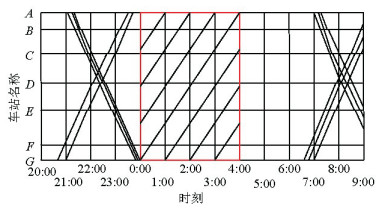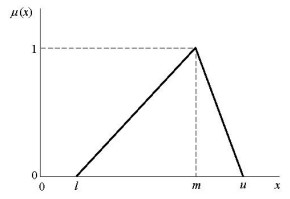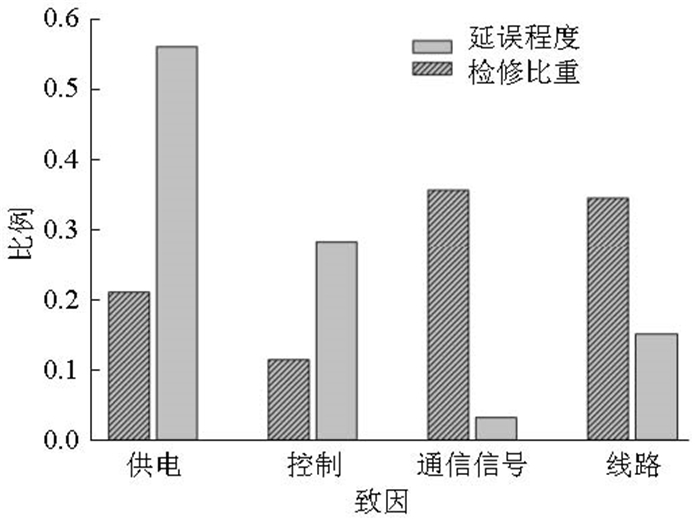Evaluation of High-Speed Railway Maintenance Plan Factors Based on Triangular Fuzzy Number
-
摘要: 为提升高速铁路施工维修水平,减少列车运行延误,对施工计划的具体内容进行效果评价,能找出检修内容的薄弱环节,从而保证高铁设施设备质量状态及列车安全稳定的运行.以实际施工计划数据为基础,对现场施工计划进行影响因子提取,建立基于供电、控制设备、车站及线路及信号及通信设备等重点检修项目内容的评价体系;引入三角模糊数和模糊评价模型,建立施工项目内容的重要度判别矩阵,判断各因子在天窗施工计划中受到重视的程度;分析实际列车延误数据,提取合并与设备故障相关的延误致因,并证明了合并后因子间的独立性;以施工计划实施后仍产生的各类型设备故障及其导致的延误列车数为指标,评价施工计划项目实施效果;最后,以某铁路局实际天窗施工计划内容、列车延误数据为实例.研究结果表明:施工维修项目重视度与设备故障导致的列车运行延误数量、晚点程度成反比;对控制设备和供电设备的检修较为薄弱,这类设备的故障是列车运行延误和晚点多发源.Abstract: In order to improve the maintenance abilities of high speed railway and reduce train delays, an evaluation system is proposed based on actual maintenance plan data. Evaluation of the railway maintenance plan is supposed to identify any weak links and contribute to the safety of the operational environment. In this system, four key maintenance plan factors are identified:power supply, control system equipment, station infrastructure, and signal and communication equipment. The triangular fuzzy number and a fuzzy evaluation method are introduced to build an importance scale matrix for estimating the importance of these four factors in maintenance plans. Delays caused by equipment and infrastructure failures are extracted and combined based on real delayed train data. These factors are also proved to be independent. Factors causing delays and the number of delayed trains are used to quantitatively measure the effects of maintenance plan factors. Finally, maintenance plan data and delayed train data from the China Railway Company are used to verify the feasibility of the method. Results show that implementing a daily HSR maintenance plan has a positive effect on decreasing train delays. The amount of attention focused on the maintenance factors is inversely proportional to the delay situation. Maintenance of control equipment and power supply equipment is weak, which is the primary cause of train delays.
-
Key words:
- maintenance plan /
- operation failure /
- train delay /
- triangular fuzzy number /
- effect
-
表 1 高速铁路天窗施工项目体系
Table 1. Factors in the high-speed railway maintenance plan
目标 二级检修项目 三级检修项目 高速铁路天窗施工维修体系 供电检修 变电所检修 接触网检修 分相检修 ⋮ 控制设备检修 列控设备检修 监控设备检修 ⋮ 车站及线路检修 车站设备及站台检修 线路探伤及维护 道岔检修维护 ⋮ 信号及通信设备检修/B4 信号机等信号设备检修 轨道电路检修 通信设备检修 ⋮ 表 2 权重判断矩阵中因子重要度的标度
Table 2. Importance scaling of factors in the weights judgment matrix
标度值 化为三角模糊数 重要度标度 备注 0.9 (0.8, 0.9, 0.9) 明显重要 前者明显重要于后者 0.7 (0.6, 0.7, 0.8) 重要 前者重要于后者 0.5 (0.4, 0.5, 0.6) 同等重要 两者同等重要 0.3 (0.2, 0.3, 0.4) 重要 后者重要于前者 0.1 (0.1, 0.1, 0.2) 明显重要 后者明显重要于前者 表 3 基于延误时长的施工项目效果评价实例
Table 3. Example of effects of maintenance factorsbased on delay time
晚点情况 施工评价 列车晚点时间/min 晚点列车数/列 轻微 非常好 <10 1 小型 好 [10, 30) 153 中型 一般 [30, 60) 286 大型 差 [60, 100] 86 严重 非常差 >100 44 表 4 高铁天窗维修计划原始数据格式
Table 4. Original data for the high-speed railway maintenance plan
调度台 等级 线路 行别 地点 日期 时间 项目 内容 BT台 Ⅲ BT城际 上行、下行、站内 TJ场站内 15年1月30日 18:00 车站及线路检修 BT城际TJ场站内, 工务在156.595 km至158.653 km处上、下行正线及站内各股道、道岔检修 JH台 维Ⅱ JH线 上行、下行 TJ至CZ西 15年1月30日 0:30至04:30 信号及通信设备检修 TJ(不含)至CZ西(不含)间上、下行线信号设备停用, 电务信号设备检修 表 5 延误时间原始数据示意表
Table 5. Original delay time data
车次 车站 图定时间 实际时间 延误致因 日期 D2312 SZ北 16:55 17:14 接触网异物 20150301 G1135 TJ南 18:20 18:37 线路沉降 20150321 表 6 因子间相关矩阵计算结果
Table 6. Correlation matrix for each combination of two factors
故障类型 供电故障 控制设备故障 车站及线路故障 信号及通信设备故障 供电故障 1.000 0.023 0.131 -0.010 控制设备故障 0.023 1.000 -0.004 -0.012 车站及线路故障 0.131 -0.004 1.000 -0.009 信号及通信设备故障 -0.010 -0.012 -0.009 1.000 表 7 延迟列车数据的总体统计分析
Table 7. Overall statistical analysis
致因 总延误/min 比例 延误列车数/列 最大列车延误/min 供电故障 23 600 0.545 570 164 控制设备故障 11 932 0.276 338 134 车站及线路故障 6 348 0.147 130 125 信号及通信设备故障 1 384 0.032 45 59 总计 43 264 1.000 1 083 — 表 8 检修后列车晚点数
Table 8. Statistical number of delayedtrains after maintenance
列 评价项目 晚点情况 轻微 小型 中型 大型 严重 合计 供电检修 1 153 286 86 44 570 控制设备检修 5 125 155 31 22 338 车站及线路检修 3 46 35 34 12 130 信号通信设备检修 0 6 39 0 0 45 表 9 施工项目因子重要度权重三角模糊数互补判断矩阵
Table 9. Triangular fuzzy number complementary judgment matrix for the degree of importance oof maintenance factors
检修项目 供电检修 控制设检修 车站及线路检修 信号及通信设备检修 供电检修 (0.500, 0.500, 0.500) (0.696, 0.752, 0.803) (0.159, 0.200, 0.246) (0.145, 0.185, 0.228) 控制设备检修 (0.197, 0.248, 0.304) (0.500, 0.500, 0.500) (0.055, 0.077, 0.104) (0.049, 0.068, 0.092) 车站及线路检修 (0.754, 0.800, 0.841) (0.896, 0.923, 0.945) (0.500, 0.500, 0.500) (0.394, 0.468, 0.542) 信号及通信设备检修 (0.772, 0.815, 0.855) (0.908, 0.932, 0.951) (0.458, 0.532, 0.606) (0.500, 0.500, 0.500) -
王辰宇.京沪高铁综合维修天窗设置方案优化研究[D].成都: 西南交通大学, 2016. 文超.高速铁路列车运行冲突管理研究[D].成都: 西南交通大学, 2012. 陶思宇, 黄树明, 屈明月.基于周期天窗的高速铁路夕发朝至列车通过能力研究[J].铁道运输与经济, 2014, 36(1):9-13. doi: 10.3969/j.issn.1003-1421.2014.01.003TAO Siyu, HUANG Shuming, QU Mingyue. Study on carrying capacity of evening-departure & morning-arrival high-speed trains based on periodical maintenance window[J]. Railway Transport and Economy, 2014, 36(1):9-13. doi: 10.3969/j.issn.1003-1421.2014.01.003 HIGGINS A. Scheduling of railway track maintenance activities and crews[J]. Journal of the Operational Research Society, 1998, 49(10):1026-1033. doi: 10.1057/palgrave.jors.2600612 VANSTEENWEGEN P, OUDHEUSDEN D V. Decreasing the passenger waiting time for an intercity rail network[J]. Transportation Research Part B Methodological, 2007, 41(4):478-492. doi: 10.1016/j.trb.2006.06.006 林宏.高速铁路综合维修计划编制方法优化研究[J].铁道运输与经济, 2017, 39(7):13-17. http://d.old.wanfangdata.com.cn/Periodical/tdysyjj201707003LIN Hong. Study on optimizing the method of high-speed railway comprehensive maintenance planning[J]. Railway Transport and Economy, 2017, 39(7):13-17. http://d.old.wanfangdata.com.cn/Periodical/tdysyjj201707003 邓永贵. V型接触网维修"天窗"对车站通过能力的影响[J].铁道运输与经济, 2003, 25(9):54-56. doi: 10.3969/j.issn.1003-1421.2003.09.024DENG Yonggui. The influence to through capacity of arrival/departure track caused by the maintenance gap of V type catenaries[J]. Railway Transport and Economy, 2003, 25(9):54-56. doi: 10.3969/j.issn.1003-1421.2003.09.024 王进勇, 闫海峰, 许绍兴. V型天窗对线路通过能力的影响[J].西南交通大学学报, 2003, 38(2):196-200. doi: 10.3969/j.issn.0258-2724.2003.02.018WANG Jinyong, YAN Haifeng, XU Shaoxing. Influence of V form skylight on carrying capacity of railways[J]. Journal of Southwest Jiaotong University, 2003, 38(2):196-200. doi: 10.3969/j.issn.0258-2724.2003.02.018 朱健梅, 闫海峰.武广客运专线天窗合理开设方式研究[J].北京交通大学学报, 2004, 28(2):107-110. doi: 10.3969/j.issn.1673-0291.2004.02.026ZHU Jianmei, YAN Haifeng. Research on reasonable mode of skylight on wuhan-guangzhou passenger special line[J]. Journal of Northern Jiaotong University, 2004, 28(2):107-110. doi: 10.3969/j.issn.1673-0291.2004.02.026 林原宏.模糊语意量表的语意模糊数建构演算与实证分析[J].中央研究院调查研究期刊, 2002, 1(11):31-71.LIN Yuanhong. The construction of fuzzy linguistic numbers for questionnaire and its empirical study[J]. Journal of Investigation and Research of Academia Sinica, 2002, 1(11):31-71. DUBIOS D, PRADE H. Operations on fuzzy numbers[J]. International Journal of Systems Science, 1978(9):613-626. http://d.old.wanfangdata.com.cn/OAPaper/oai_doaj-articles_4a09278cf50188adb9658754e1e2f775 DIJKMAN J G, VAN HAERINGEN H, DE LANGE S J. Fuzzy numbers[J]. Journal of Mathematical Analysis and Applications, 1983, 92(2):301-341. doi: 10.1016/0022-247X(83)90253-6 ZHU K J, JING Y, CHANG D Y. A discussion on extent analysis method and applications of fuzzy AHP[J]. European journal of operational research, 1999, 116(2):450-456. doi: 10.1016/S0377-2217(98)00331-2 CHANG D Y. Applications of the extent analysis method on fuzzy AHP[J]. European Journal of Operational Research, 1996, 95(3):649-655. doi: 10.1016/0377-2217(95)00300-2 徐泽水.基于FOWA算子的三角模糊数互补判断矩阵排序法[J].系统工程理论与实践, 2003, 23(10):86-89. doi: 10.3321/j.issn:1000-6788.2003.10.014XU Zeshui. A priority method for triangular fuzzy number complementary judgement matrix[J]. Systems Engineering Theory & Practice, 2003, 23(10):86-89. doi: 10.3321/j.issn:1000-6788.2003.10.014 张孝远, 陈凯华.基于三角模糊数的综合评价体系的研究[J].中国科技论文在线, 2006, 5:317-324. http://d.old.wanfangdata.com.cn/Thesis/Y3113921ZHANG Xiaoyuan, CHEN Kaihua. Research on comprehensive appraisal system on triangular fuzzy number[J]. Sciencepaper Online, 2006, 5:317-324. http://d.old.wanfangdata.com.cn/Thesis/Y3113921 马莉, 周杰, 吴翠芳.基于三角模糊数的高校教师学术评价方法研究[J].统计与管理, 2016(5):180-182. http://d.old.wanfangdata.com.cn/Periodical/tjygl201605092MA Li, ZHOU Jie, Wu Cuifang. Research on academic evaluation for university teachers on triangular fuzzy number[J]. Statistics and Management, 2016(5):180-182. http://d.old.wanfangdata.com.cn/Periodical/tjygl201605092 徐泽水.模糊互补判断矩阵排序的最小方差法[J].系统工程理论与实践, 2001, 21(10):93-96. doi: 10.3321/j.issn:1000-6788.2001.10.016XU Zeshui. The least variance priority method (LVM) for fuzzy complementary judgement matrix[J]. System Engineering Theory and Practice, 2001, 21(10):93-96. doi: 10.3321/j.issn:1000-6788.2001.10.016 魏翠萍.层次分析法中和积法的最优化理论基础及性质[J].系统工程理论与实践, 1999, 19(9):113-115. http://www.wanfangdata.com.cn/details/detail.do?_type=perio&id=QK199900735630WEI Cuiping. The optimization basis and properties of the sum-product method in AHP[J]. System Engineering Theory and Practice, 1999, 19(9):113-115. http://www.wanfangdata.com.cn/details/detail.do?_type=perio&id=QK199900735630 YANG Yuxiang, LI Jie, WEN Chao, et al. Statistical distribution analysis of high-speed railway delay causes: evidence from guangzhou railway corporation in China[C]//RailLille 2017: the 7th International Conference on Railway Operations Modelling and Analysis. Lille: [s.n.], 2017: 1511-1531. LEE E S, LI R J. Comparison of fuzzy numbers based on the probability measure of fuzzy events[J]. Computers & Mathematics with Applications, 1988, 15(10):887-896. doi: 10.1016-0898-1221(88)90124-1/ -






 下载:
下载:



